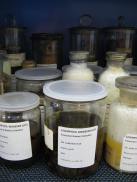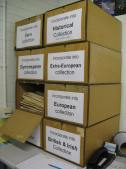Month: May 2012
Museum Allotment in May

I’ve been waiting to finally take a photo of the allotment in the sunshine – and now we’ve had a whole glorious week of it. The allotment has been quite thirsty and everyone will have to help to keep it well-watered. Andrew has certainly been doing his bit for the museum veg and there are more photos to be seen on his latest post. Now it’s in the afternoon shade and I think the pink deckchairs are looking mightily inviting. Time to escape the tower and visit the live plant specimens!
Spring Gentian
Now is the time for all keen botanists to head to the hills. The Spring Gentian is a sight not to be missed and it is in flower now. This plant is an arctic-alpine species with very special requirements and grows in only a few places. It is easy to see inUpper Teesdale(Cow Green Reservoir) and on The Burren in the West of Ireland but the weather has to be bright as the flowers close up if there is insufficient sun.
The day we made our expedition was not promising and although it was May it was cold and windy with overcast skies. However, there were many plants, almost hidden in the grass with petals tightly closed. One or two flurries of snow dampened our spirits and we found some Bird’s Eye Primrose to photograph instead. A Golden Plover kept a wary eye on us from a distance and then flew away. Many other interesting plants grow in the reserve but few are in flower so early in such an inhospitable place. At length patience paid off and the skies brightened. The brief sunny spell was sufficient for several of the flowers to open and photographs were duly taken. They really are a startling blue and on a sunny day must be a wonderful sight. I imagine the Victorian botanists took a great many plants for herbaria but we are more enlightened nowadays and the plants are protected by law from humans and by fencing from rabbits.
A short walk to view Cauldron Snout is recommended and warmed us up on a cold day.
The Spring Gentian featured on a UK postage stamp in 1964.
by Christine Walsh, Botany volunteer
Pickled plants
Most of the specimens in the herbarium at the Manchester Museum are pressed and mounted on sheets of paper, or seeds in glass-lidded boxes or slices of tree trunk stacked in a drawer. But what if we want to preserve the structure of a flower or a fruit that’s too big to press and too wet to dry before it goes mouldy?
Well, one answer is to store the specimen in a glass jar of spirit solution. The actual compostition of this fluid varies, but is generally a mixture of water and industrial methylated spirits, with glycerol and formaldehyde.
Here in Manchester, we have around 300 spirit specimens, many of which are beautifully preserved and hopefully a few will be displayed on our new gallery, Nature’s Library. Sadly, some have been neglected, to the point where they have completely dried out and cannot be salvaged.
I have been working with our current Curatorial Trainee, Andrew Lawton, and our previous Curatorial Trainee, Gina Allnat, and volunteer Veronica, to clean, list and photograph these spirit specimens. Andrew and Gina have both written blog posts about this project.












 We have been working on our spirit specimens in Manchester recently so were very interested in Liverpool’s spirit store and new jars.
We have been working on our spirit specimens in Manchester recently so were very interested in Liverpool’s spirit store and new jars.











